 |
Please display it as a web page clicking here when it is not correctly displayed. |
 |
|
 |
|
|
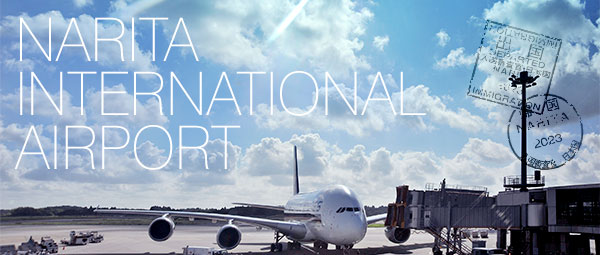 |
|
|
|
|
 |
|
|
|
Greetings from the Narita Airport email newsletter editorial office.
We hope you are surviving this long spell of hot weather. Narita Airport in August has been full of customers traveling with family and friends, making it a very lively summer.
We went inside Narita Airport's fuel facility complex at an event held this month to mark the 40th anniversary of the commencement of operations of the airport's fuel pipeline*! We will explain the fuel facilities and aviation fuel with some photos taken on the day, so we hope you enjoy this article through to the end.
* Pipeline: A pipeline for fuel to be supplied to aircraft. |
 |
 |
 |
 |
 |
 |
 |
 |
| ・ |
A Peek at Narita Airport's Fuel Facilities - Revealing Narita Airport's Aviation Fuel Secret! |
|
 |
 |
 |
|
 |
 |
 |
 |
 |
 |
| ・ |
Introducing "Mono to Art", a Store that Sells Art you can Use |
|
 |
 |
 |
|
 |
 |
 |
 |
 |
 |
| ・ |
Biman Bangladesh Airlines will Launch a new service to Dhaka on September 2! |
| ・ |
AERO K AIRLINES Launches a New Service to Cheongju on August 3! |
|
 |
 |
 |
|
 |
 |
 |
 |
 |
 |
| ・ |
"Japan Food Hall", a Restaurant Floor with the Taste of "Japan" will Open on the After Passport Control in Terminal 2. |
| ・ |
"Fa-So-La TAX FREE AKIHABARA+" And "Matsumotokiyoshi" will Open on the After Passport Control in Terminal 2. |
| ・ |
AirJapan to Launch Narita - Bangkok Service On 9 February 2024 |
|
 |
 |
 |
|
 |
|
 |
 |
 |
 |
 |
A Peek at Narita Airport's Fuel Facilities - Revealing Narita Airport's Aviation Fuel Secret! |
 |
| Aircraft are an indispensable mode of travel. Do you know how the aviation fuel for those aircraft gets to the airport? You might be surprised to learn that it is transported to Narita Airport along a 47-kilometer long pipeline from Chiba Port. This pipeline celebrated its 40th anniversary of operation in August this year. I joined a tour of Narita Airport fuel facilities for elementary students on summer vacation, which was organized as part of the anniversary celebrations. |
 |
| Pipeline start point! Fuel terminal |
 |
 |
Chiba Port Aviation Fuel Terminal is the closest seaport to Narita Airport. It is the starting point for the pipeline transporting jet fuel used at Narita Airport and is fed by shipments of fuel from domestic refineries throughout Japan. Chiba Port Aviation Fuel Terminal can handle 9 million kiloliters a year with a maximum storage capacity of 104,000 kiloliters. Around 8,000 kiloliters of fuel a day (enough for 100 passenger planes) travels along the pipeline to Narita Airport!
Only Narita Airport, the sole landlocked airport in Japan, transports fuel by pipeline.
In a testing laboratory, this facility also carries out quality inspections on the incoming fuel. The test items are diverse and include, for example, checks for impurities and checks to ensure that the fuel does not freeze in the air at -50 degrees Celsius.
<What is aviation fuel made from?>
Aviation fuel is normally refined from crude oil, is similar in properties to kerosene used in stoves, and is colorless and transparent. It is called JETA1 and must be of uniform quality no matter where in the world it is used.
Focus on jet fuel has intensified in recent years, especially in regard to SAF*1! SAF is also recognized as next-generation aviation fuel, and because it is refined from sustainable sources that emit less CO2 in the process from the production and collection of raw materials to combustion than the fossil fuels typically used in refining jet fuel. SAF has been at Narita Airport since October 2020.
*1 Sustainable Aviation Fuel |
 |
| Pipeline secret |
 |
 |
 |
As we mentioned in the introduction, the pipeline is approximately 47 kilometers long and the fuel flows through at a velocity of 2.2 meters a second. A section of 8 kilometers is buried around 30 meters underground*2 and is walked daily for safety checks.
* Tunnel |
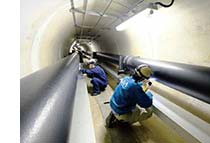 |
 |
 |
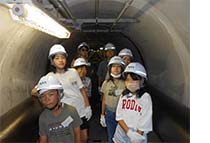 |
During this tour, we were given special access to the tunnel! The temperature on that day was 35 degrees Celsius but inside the tunnel it was pleasantly cool, a world apart from the outside. The participants in the tour were very interested in the secret areas of the pipeline which are usually never seen the public. |
 |
| Final pipeline destination - Fuel Center 1 |
 |
 |
Fuel Center 1 at Narita Airport contains storage tanks for the fuel delivered by the pipeline, and it is from here that the fuel is sent to the aircraft. There are 25 tanks with a total storage capacity of 144,000 kiloliters. These provide the ability to maintain a constant reserve of fuel even if supply from the pipeline is interrupted by an earthquake or other event and, combined with Fuel Center 2 built in a separate area for temporary storage, there is a constant reserve of at least 7 days' worth of fuel at the airport.
|
 |
| Fuel at its final destination on the aircraft! Apron refueling. |
 |
 |
Narita Airport has a vast network of underground fuel supply pipes. The fuel travels through this network to the apron where it is delivered to aircraft by hoses carried in vehicles called "servicers". The aircraft we saw being refueled on the day was a Boeing 787. Planeside refueling took about 30 minutes to deliver approximately 52 kiloliters of fuel.
<Where are the aircraft's fuel tanks?>
The fuel tanks are located inside the wings. The reason for this is to reduce the load on the wings. Some people might wonder if carrying fuel in the wings wouldn't add weight to them. However, this does not pose a problem because aircraft use the weight of the fuel to maintain the strength of the fuselage. If the fuel tanks were in the fuselage, the heavier fuselage would be pulled down while the lighter wings would be pulled up. This could make the load unbearable. To prevent this, the fuel in the wings adds weight so that the wings do not flex more than necessary. |
 |
| Interview with tour participant |
 |
 |
| Neo Aoyagi |
 |
 |
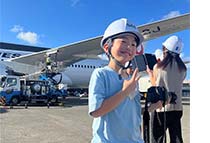 |
- What was the best part of this tour?
Refueling on the apron was a lot of fun because we could see the planes up close. I used to like trains, but after this tour, I think I like planes too! |
 |
| [ From Our Editorial Staff ] |
 |
 |
This was our first visit to the fuel facilities. We were surprised at the size of the facilities which are unique to Narita, a landlocked airport, and it reminded us of the scale of the airport!
We also found out that there are markers along the pipeline to Narita Airport to show the location of the pipeline underground.
If you live close to the pipeline, you should be able to see the marker poles nearby. |
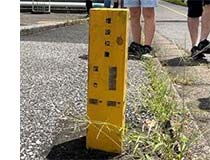 |
|
 |
 |
 |
 |
 |
Introducing "Mono to Art", a Store that Sells Art you can Use |
 |
The products handled at Mono to Art's first store at Narita Airport are all one-of-a-kind. It is an exciting space where even identical items look and feel different and where you can search for a personal favorite.
Miscellaneous "everyday use" items created by around 40 up-and-coming artists are unique and will not be seen on anybody else. The store is decorated by unique miscellaneous goods and stationery hand-painted by young artists, not printed, as well as artistic glass accessories and unique ceramics. |
 |
 |
 |
Hand-painted project: Hand-painted message cards and stationery
275 yen - 13,200 yen |
 |
 |
 |
ayanofukumura "Katsushika Hokusai's Great Wave of Kanagawa" glass accessories
5,900 yen - 24,200 yen |
 |
| Gift wrapping available only at Narita Airport is also available for those looking for a gift that really stands out. Come find your own unique treasure. |
|
 |
 |
 |
 |
 |
Biman Bangladesh Airlines will Launch a new service to Dhaka on September 2! |
 |
 |
Dhaka is the capital of Bangladesh and one of the world's mega-cities. It is the administrative, cultural and commercial heart of the country.Biman Bangladesh Airlines is the national flag carrier of Bangladesh and will be the only airline to connect Dhaka and Narita in six and a half hours. The service will be the first direct flight from Narita to Dhaka.Take advantage of Narita Airport's network, now even more convenient with the new Biman Bangladesh Airlines service.
*Details |
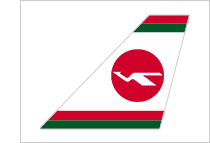 |
|
 |
 |
 |
AERO K AIRLINES Launches a New Service to Cheongju on August 3! |
 |
 |
Cheongju is located almost in the center of South Korea and in ancient times it flourished as Baekje, the place of origin of the famous delicacy, Samgyeopsal (grilled pork belly). Visitors can experience the history of the area at Cheongju National Museum and learn about the national printing culture at the Cheongju Early Printing Museum. Alternatively, you can visit fashionable cafés and film locations along Suamgol café street. Visit Cheongju with AERO K AIRLINES, the first direct service from Narita.
*Details |
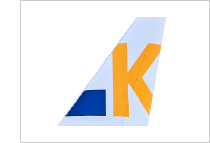 |
|
 |
 |
 |
| I hope you enjoyed our August edition. This month, we touched on some of the "deeper" facilities at the airport. We sincerely hope that our readers, as well as the participants in the tour, were able to gain a deeper understanding of the fuel facilities at Narita Airport. Thanks for reading. See you next month. |
|
 |
|
|
|
|
|
|
 |
|
 |
|
|
|
